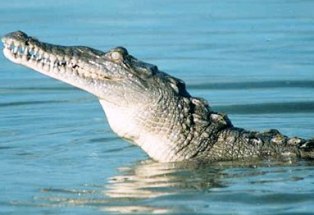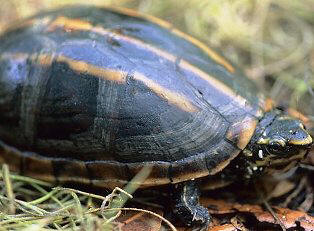Florida's endangered reptiles
Florida has six endangered reptile species, eleven threatened
species and seven species of special concern for a total of twenty
four reptiles at risk in Floridian nature. Reptiles have been around for 300 million
years, and during the age of the dinosaurs, they ruled the Earth. Some
6,500 species of reptiles still thrive today. There are more than 8,000
species of reptiles on the planet, and the live on every continent
except Antarctica ."Cold-blooded" is not the best way to describe
reptiles- they get their body heat from external sources. Reptiles
cannot regulate their body temperature internally as humans do. Reptiles
are among the longest-lived species on the planet. For example, large
tortoises such as the Aldabra tortoise can live for more than 150 years.
Alligators can live nearly 70 years. Ball pythons, a popular type of pet
snake, can live up to 40 years
American crocodiles are endangered in Florida. They live in coastal areas throughout the Caribbean, and occur at the northern end of their range in south Florida. They live in brackish or saltwater areas, and can be found in ponds, coves, and creeks in mangrove swamps. Unlike the American Alligator, the American Crocodile has a narrow snout, and both upper and lower teeth are exposed on the crocodile when his mouth is closed. American crocodiles are more of a grayish green in color, while alligators are a darker black. Crocodiles can be seen sunning with their mouths open, or “gaping.” This behavior is related to regulating their body temperature, and does not mean that the crocodile is acting aggressively toward people. The American crocodile is so rare and shy of man that conflict with people rarely occurs.
Another endangered reptile in Florida is the striped mud turtle. Throughout much of its range in Florida, the striped mud turtle is characterized by yellow head stripes and three light longitudinal stripes on a dark brown carapace. This turtle is only 3 to 4 inches in length and has a double-hinged plastron, similar to the eastern box turtle. The sexes can be distinguished by the longer, thicker tails of males. The striped mud turtle is different from most other turtles species in the Southeast in that females nest in the fall, rather than the spring or summer. Striped mud turtles inhabit calm freshwater habitats, such as swamps and canals with soft substrates and are most common in cypress swamps and blackwater creeks.
American crocodiles are endangered in Florida. They live in coastal areas throughout the Caribbean, and occur at the northern end of their range in south Florida. They live in brackish or saltwater areas, and can be found in ponds, coves, and creeks in mangrove swamps. Unlike the American Alligator, the American Crocodile has a narrow snout, and both upper and lower teeth are exposed on the crocodile when his mouth is closed. American crocodiles are more of a grayish green in color, while alligators are a darker black. Crocodiles can be seen sunning with their mouths open, or “gaping.” This behavior is related to regulating their body temperature, and does not mean that the crocodile is acting aggressively toward people. The American crocodile is so rare and shy of man that conflict with people rarely occurs.
Another endangered reptile in Florida is the striped mud turtle. Throughout much of its range in Florida, the striped mud turtle is characterized by yellow head stripes and three light longitudinal stripes on a dark brown carapace. This turtle is only 3 to 4 inches in length and has a double-hinged plastron, similar to the eastern box turtle. The sexes can be distinguished by the longer, thicker tails of males. The striped mud turtle is different from most other turtles species in the Southeast in that females nest in the fall, rather than the spring or summer. Striped mud turtles inhabit calm freshwater habitats, such as swamps and canals with soft substrates and are most common in cypress swamps and blackwater creeks.



Comments
Post a Comment